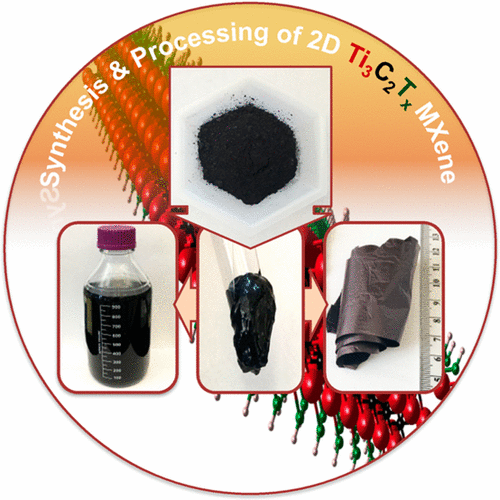当前位置:
X-MOL 学术
›
Chem. Mater.
›
论文详情
Our official English website, www.x-mol.net, welcomes your feedback! (Note: you will need to create a separate account there.)
Guidelines for Synthesis and Processing of Two-Dimensional Titanium Carbide (Ti3C2Tx MXene)
Chemistry of Materials ( IF 8.6 ) Pub Date : 2017-09-06 00:00:00 , DOI: 10.1021/acs.chemmater.7b02847 Mohamed Alhabeb 1 , Kathleen Maleski 1 , Babak Anasori 1 , Pavel Lelyukh 1 , Leah Clark 1 , Saleesha Sin 1 , Yury Gogotsi 1
Chemistry of Materials ( IF 8.6 ) Pub Date : 2017-09-06 00:00:00 , DOI: 10.1021/acs.chemmater.7b02847 Mohamed Alhabeb 1 , Kathleen Maleski 1 , Babak Anasori 1 , Pavel Lelyukh 1 , Leah Clark 1 , Saleesha Sin 1 , Yury Gogotsi 1
Affiliation

|
Two-dimensional (2D) transition metal carbides, carbonitrides, and nitrides (MXenes) were discovered in 2011. Since the original discovery, more than 20 different compositions have been synthesized by the selective etching of MAX phase and other precursors and many more theoretically predicted. They offer a variety of different properties, making the family promising candidates in a wide range of applications, such as energy storage, electromagnetic interference shielding, water purification, electrocatalysis, and medicine. These solution-processable materials have the potential to be highly scalable, deposited by spin, spray, or dip coating, painted or printed, or fabricated in a variety of ways. Due to this promise, the amount of research on MXenes has been increasing, and methods of synthesis and processing are expanding quickly. The fast evolution of the material can also be noticed in the wide range of synthesis and processing protocols that determine the yield of delamination, as well as the quality of the 2D flakes produced. Here we describe the experimental methods and best practices we use to synthesize the most studied MXene, titanium carbide (Ti3C2Tx), using different etchants and delamination methods. We also explain effects of synthesis parameters on the size and quality of Ti3C2Tx and suggest the optimal processes for the desired application.
中文翻译:

二维碳化钛(Ti 3 C 2 T x MXene)的合成和加工指南
二维(2D)过渡金属碳化物,碳氮化物和氮化物(MXenes)于2011年被发现。自最初发现以来,通过选择性蚀刻MAX相和其他前驱物,合成了20多种不同的成分,并且在理论上还有更多预测。它们具有多种不同的特性,使该系列产品有望在广泛的应用中使用,例如能量存储,电磁干扰屏蔽,水净化,电催化和医学。这些可溶液处理的材料具有高度可扩展性,通过旋涂,喷涂或浸涂沉积,上漆或印刷或以各种方式制造的潜力。由于这一希望,对MXene的研究量不断增加,合成和加工方法也在迅速扩展。材料的快速发展也可以在决定分层产量以及所生产2D薄片质量的广泛合成和加工方案中注意到。在这里,我们描述了用于合成研究最多的MXene,碳化钛(Ti3 C 2 T x),使用不同的蚀刻剂和分层方法。我们还解释了合成参数对Ti 3 C 2 T x的尺寸和质量的影响,并提出了所需应用的最佳工艺。
更新日期:2017-09-07
中文翻译:

二维碳化钛(Ti 3 C 2 T x MXene)的合成和加工指南
二维(2D)过渡金属碳化物,碳氮化物和氮化物(MXenes)于2011年被发现。自最初发现以来,通过选择性蚀刻MAX相和其他前驱物,合成了20多种不同的成分,并且在理论上还有更多预测。它们具有多种不同的特性,使该系列产品有望在广泛的应用中使用,例如能量存储,电磁干扰屏蔽,水净化,电催化和医学。这些可溶液处理的材料具有高度可扩展性,通过旋涂,喷涂或浸涂沉积,上漆或印刷或以各种方式制造的潜力。由于这一希望,对MXene的研究量不断增加,合成和加工方法也在迅速扩展。材料的快速发展也可以在决定分层产量以及所生产2D薄片质量的广泛合成和加工方案中注意到。在这里,我们描述了用于合成研究最多的MXene,碳化钛(Ti3 C 2 T x),使用不同的蚀刻剂和分层方法。我们还解释了合成参数对Ti 3 C 2 T x的尺寸和质量的影响,并提出了所需应用的最佳工艺。


























 京公网安备 11010802027423号
京公网安备 11010802027423号